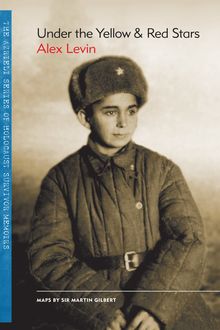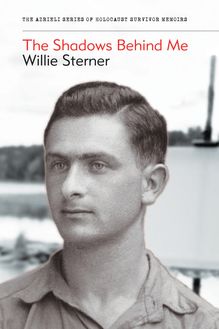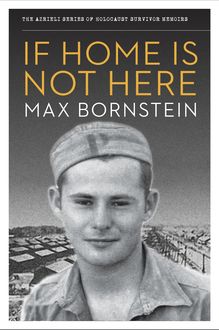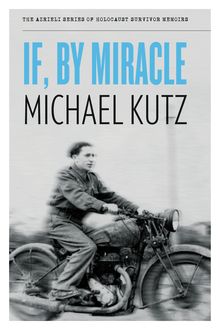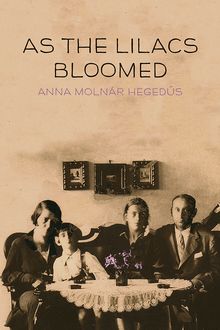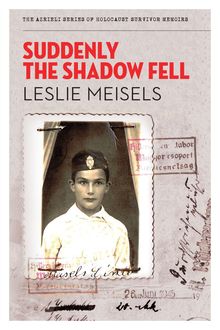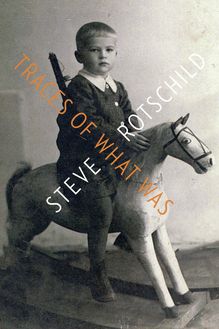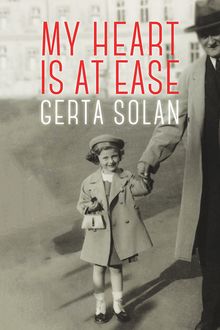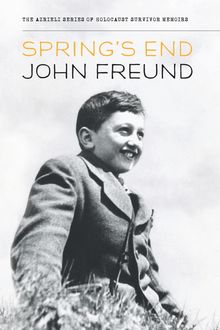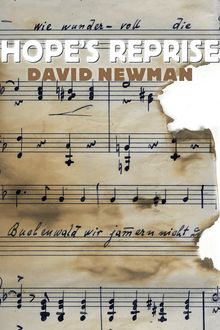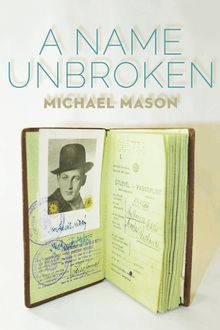-
 Univers
Univers
-
 Ebooks
Ebooks
-
 Livres audio
Livres audio
-
 Presse
Presse
-
 Podcasts
Podcasts
-
 BD
BD
-
 Documents
Documents
-
- Cours
- Révisions
- Ressources pédagogiques
- Sciences de l’éducation
- Manuels scolaires
- Langues
- Travaux de classe
- Annales de BEP
- Etudes supérieures
- Maternelle et primaire
- Fiches de lecture
- Orientation scolaire
- Méthodologie
- Corrigés de devoir
- Annales d’examens et concours
- Annales du bac
- Annales du brevet
- Rapports de stage
La lecture à portée de main
Vous pourrez modifier la taille du texte de cet ouvrage
Découvre YouScribe en t'inscrivant gratuitement
Je m'inscrisDécouvre YouScribe en t'inscrivant gratuitement
Je m'inscrisEn savoir plus
Vous pourrez modifier la taille du texte de cet ouvrage
En savoir plus

Description
Sujets
Informations
| Publié par | Azrieli Foundation |
| Date de parution | 01 septembre 2009 |
| Nombre de lectures | 2 |
| EAN13 | 9781897470626 |
| Langue | English |
| Poids de l'ouvrage | 1 Mo |
Informations légales : prix de location à la page 0,0300€. Cette information est donnée uniquement à titre indicatif conformément à la législation en vigueur.
Extrait
A Drastic Turn of Destiny
Fred Mann
The Azrieli Series of Holocaust Survivor Memoirs
SERIES II: SENIOR EDITORIAL BOARD
Sara R. Horowitz, Chair Irving Abella Naomi Azrieli Michael Brown Janet Webber Mark Webber
Senior Editor for this volume: Mark Webber
Andrea Knight, Managing Editor Elin Beaumont, Program Coordinator Aurélien Bonin, Research & Translation Erika Tucker, Program Assistant Jody Spiegel, Executive Coordinator
Tamarah Feder, Managing Editor & Program Manager (2005–08)
Mark Goldstein, Art Director Maps by Sir Martin Gilbert and François Blanc
Contents
Introduction
Growing Up under Hitler
The First Exodus
The Second Exodus
The Third Exodus
The Fourth Exodus
The Fifth Exodus
Glossary
Maps & Photographs
Index
Copyright
About the Azrieli Foundation
Also Available
Series Preface:In their own words...
In telling these stories, the writers have liberated themselves. For so many years we did not speak about it, even when we became free people living in a free society. Now, when at last we are writing about what happened to us in this dark period of history, knowing that our stories will be read and live on, it is possible for us to feel truly free. These unique historical documents put a face on what was lost, and allow readers to grasp the enormity of what happened to six million Jews – one story at a time.
David J. Azrieli, C.M., C.Q., MArch Holocaust survivor and founder, The Azrieli Foundation
Since the end of World War II , over 30,000 Jewish Holocaust survivors have immigrated to Canada. Who they are, where they came from, what they experienced and how they built new lives for themselves and their families are important parts of our Canadian heritage. The Azrieli Foundation-York University Holocaust Survivor Memoirs Program was established to preserve and share the memoirs written by those who survived the twentieth-century Nazi genocide of the Jews of Europe and later made their way to Canada. The program is guided by the conviction that each survivor of the Holocaust has a remarkable story to tell, and that such stories play an important role in education about tolerance and diversity.
Millions of individual stories are lost to us forever. By preserving the stories written by survivors and making them widely available to a broad audience, the Azrieli Series of Holocaust Survivor Memoirs seeks to sustain the memory of all those who perished at the hands of hatred, abetted by indifference and apathy. The personal accounts of those who survived against all odds are as different as the people who wrote them, but all demonstrate the courage, strength, wit and luck that it took to prevail and survive in such terrible adversity. The memoirs are also moving tributes to people – strangers and friends – who risked their lives to help others, and who, through acts of kindness and decency in the darkest of moments, frequently helped the persecuted maintain faith in humanity and courage to endure. These accounts offer inspiration to all, as does the survivors’ desire to share their experiences so that new generations can learn from them.
The Holocaust Survivor Memoirs Program collects, archives and publishes these distinctive records and the print editions are available free of charge to libraries, schools and Holocaust-education programs across Canada, and to the general public at Azrieli Foundation educational events. Online editions of the books are available on our web site, www.azrielifoundation.org .
The Israel and Golda Koschitzky Centre for Jewish Studies has provided scholarly assistance and guidance in the preparation of these memoirs for publication. The manuscripts as originally submitted are preserved in the Clara Thomas Archives and Special Collections at York University, and are available for review by interested scholars.
The Azrieli Foundation would like to express deep appreciation to Tamarah Feder, Managing Editor and Program Manager 2005–2008 for her contribution to the establishment of this program and for her work on Series i and ii. We also gratefully acknowledge the following people for their invaluable efforts in producing this series: Mary Arvanitakis, Elin Beaumont, François Blanc, Aurélien Bonin, Florence Buathier, Mark Celinscack, Nicolas Côté, Jordana de Bloeme, Darrel Dickson (Maracle Press), Andrea Geddes Poole, Sir Martin Gilbert, Esther Goldberg, Mark Goldstein, Elizabeth Lasserre, Lisa Newman, Carson Phillips, Susan Roitman, Judith Samuels, Randall Schnoor, Erica Simmons, Jody Spiegel, Mia Spiro, Erika Tucker and Karen Van Kerkoerle.
Introduction
Fred Mann’s account of his own and his family’s journey from Germany to Belgium, France, Portugal and then to Jamaica before coming to Canada is an extraordinarily well-remembered memoir of a young boy who was forced to grow up – and grow more Jewish – under the mortal pressure applied by the Nazis and their helpers. Fred Mann recounts, sometimes humorously, frequently unabashedly, what he saw and experienced as a teenager. Told from the perspective of the adolescent boy of the day, Mann’s story includes (as truth demands) his conflicts with his father (to whom he is nevertheless bound in deep affection and respect); his biting disdain for those who seek to take advantage of the precarious situation of Jewish refugees; his gratitude to the Christians and Jews who help when helping is not easy; his dedication to school and work; and his remarkably varied, prolific, and literally “pre-mature” erotic life.
Singular as Fred Mann’s chronicle is, it also contains many familiar elements. At times it is reminiscent of The Odyssey and also has aspects of Casablanca . But the memoir’s chapter titles indicate that, to its author, his journey was actually a twentieth-century version of the biblical exodus. It is indeed a story of “going forth” from the hand of tyranny and destruction to a new land of freedom. At the same time, it is an account of a boy’s coming of age – religiously (with the celebration of Fred’s bar mitzvah, a year late, in Belgium), sexually, and in terms of the responsibility Fred assumes for the well-being of his family. Ultimately, it is a relatively positive story, despite tragic losses within Fred’s family and in the larger context.
The personal account is enriched by the political contextualization that Mann provides. The Mann family’s journey takes place amidst the unfolding repression, exclusion and, finally, murder of a large part of European Jewry. The centrifugal stations of the journey give Fred Mann important information on specific situations at specific times, but he never loses sight of the larger context. In fact, the Manns’ ability to realistically assess the state of their relative vulnerability or safety was an important factor in keeping them alive by allowing them to decide whether to stay where they were or move on (and if to move, then where they should go).
Fred Mann’s story is unique in the perspective it brings to the events, processes and experiences of the Holocaust – in the closely observed and detailed description it provides of life under tyranny, occupation, and mortal danger; and in the range of people, places and events it portrays. The author is blessed with the intelligence, determination and ingenuity (and luck) to exploit opportunities and avoid potentially disastrous traps. He is also possessed of the natural storyteller’s sense of how to weave a complex but fascinating narrative from many intertwined strands, all the while keeping the reader’s empathy and interest.
* * *
Fred Mann, whose German name was Manfred Lothar Mann, was born at his parents’ home in Leipzig on February 28, 1926. Fred (or Fredi, as he was known to his German family) was the second son of Emanuel Mann, who was born in Vienna in 1889, and Zelda Mann, née Waldmann, who was born in Zgierz, Poland, north of Lodz, in 1896. 1 Emanuel and Zelda Mann met in Leipzig and married there in 1922. Thus, although Fred was a “German Jew,” his family history made him and his relatives both sensitive and susceptible to the fates of Jews in Poland and Austro-Hungary.
Leipzig, located in eastern Germany, was both a thriving city and a favoured commercial and immigration destination for Jews from Poland, the Habsburg Empire, and points east. When Fred Mann was born, more than two-thirds of Leipzig’s Jews had been born outside Germany. 2 In this regard, the Manns were typical. They were also typical in that Mann’s grandfather was a furrier. After the commercial laws and restrictions on Jewish settlement had been liberalized in the nineteenth century, more and more Eastern European Jews, particularly those in the fur business, having been drawn initially to the city’s trade fair, made Leipzig their home. 3 Here the Manns flourished, although they moved away from the fur trade and the core of the Jewish district to other enterprises and a neighbourhood that was not identified or identifiable as Jewish.
Before the rise of National Socialism, Fred’s extended and nuclear family was already well-integrated into the majority Christian society, with relatives having served in the Austro-Hungarian army and in the Polish Sejm. The language of the Mann household in Leipzig was German, although Fred’s paternal grandparents knew Yiddish. The sons received quintessentially German names – Heinz Arno and Manfred Lothar. They attended public school until they were forced by the Nazis to go to a Jewish school. Fred’s father had non-Jewish as well as Jewish friends and wanted his family to live a life more-or-less “indistinguishable from the non-Jewish population.” 4
Gradually, the family grew less st
-
 Univers
Univers
-
 Ebooks
Ebooks
-
 Livres audio
Livres audio
-
 Presse
Presse
-
 Podcasts
Podcasts
-
 BD
BD
-
 Documents
Documents
-
Jeunesse
-
Littérature
-
Ressources professionnelles
-
Santé et bien-être
-
Savoirs
-
Education
-
Loisirs et hobbies
-
Art, musique et cinéma
-
Actualité et débat de société
-
Jeunesse
-
Littérature
-
Ressources professionnelles
-
Santé et bien-être
-
Savoirs
-
Education
-
Loisirs et hobbies
-
Art, musique et cinéma
-
Actualité et débat de société
-
Actualités
-
Lifestyle
-
Presse jeunesse
-
Presse professionnelle
-
Pratique
-
Presse sportive
-
Presse internationale
-
Culture & Médias
-
Action et Aventures
-
Science-fiction et Fantasy
-
Société
-
Jeunesse
-
Littérature
-
Ressources professionnelles
-
Santé et bien-être
-
Savoirs
-
Education
-
Loisirs et hobbies
-
Art, musique et cinéma
-
Actualité et débat de société
- Cours
- Révisions
- Ressources pédagogiques
- Sciences de l’éducation
- Manuels scolaires
- Langues
- Travaux de classe
- Annales de BEP
- Etudes supérieures
- Maternelle et primaire
- Fiches de lecture
- Orientation scolaire
- Méthodologie
- Corrigés de devoir
- Annales d’examens et concours
- Annales du bac
- Annales du brevet
- Rapports de stage

